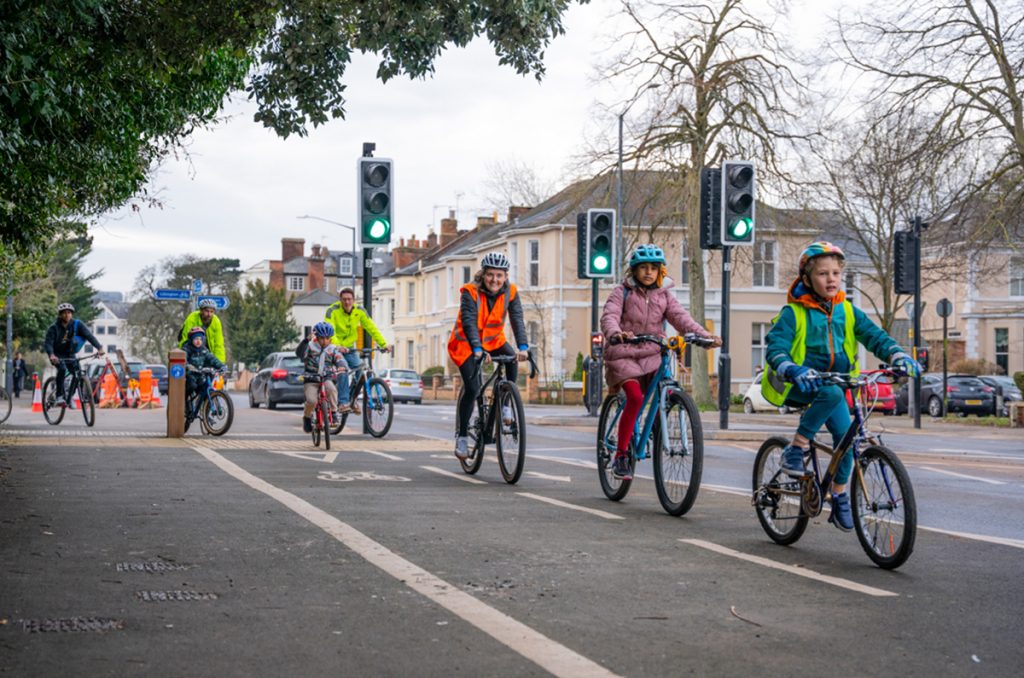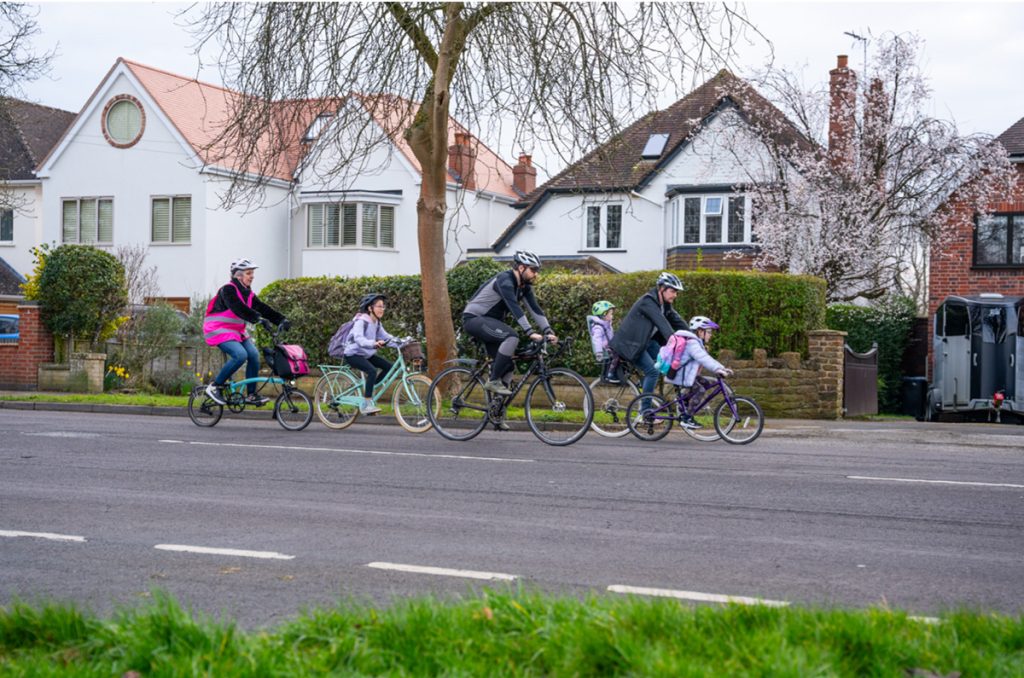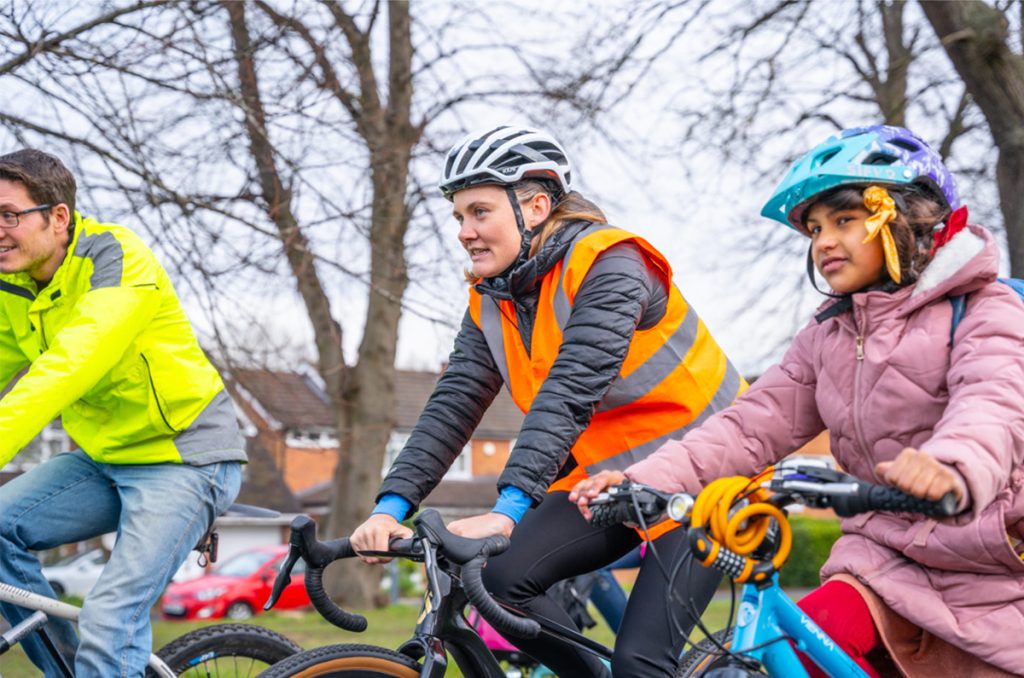Get more kids on bikes with a community-led ‘Bike Bus’
In Warwickshire, a simple but powerful idea is helping more children cycle to school: the school bike bus.
Annabel Precious – Director at The Transportation Consultancy (ttc), keen cyclist and passionate advocate for sustainable transport – has teamed up with Fran Smith from bike company Hiplok to run a local bike bus every “F-Ride-day.”

Supported by Warwickshire’s Local Bicycle Mayor, Simon Storey, the initiative is all about making cycling a fun, safe and social way for kids to get to school – and to help more families feel confident choosing bikes over cars for school runs and local outings.
Annabel explains what a bike bus is and how you can get your own bus bike on the road!
Q – What is a Bike Bus?
A bike bus is when a group of people cycle along a set route with organised stops to collect more cyclists on the way. For schools in particular, an organised bike bus is a great way to get more pupils cycling to school, adhering to the idea of “safety in numbers”. Our bike bus runs every Friday but more established buses within the area run more regularly, where participation increases.
Q – Is a bus bike safe?
Yes – when well organised, bike buses are very safe. Adult riders help manage road safety, and high-visibility clothing, music, lights and careful route planning all help. Many groups also work with local councils or schools to get advice and support. It’s helpful to have two group riders, one to stop traffic at junctions, and the other to lead the group. Parent riders stay on the outside of the children riding, to keep the group of riders together and safe.
Q – What are the benefits?
Cycling to school is not only beneficial for children’s health and fitness but it has also been proven to increase focus and concentration in the classroom. Cycling in a group as part of an organised bike bus, provides a safe and fun way to bike to school while building kid’s confidence and skills in cycling as part of active travel. Of course, from a wider community point of view, it also decreases the amount of vehicle congestion and subsequent pollution around the school.

Q – How exactly does a Bus Bike work?
Depending on the number of people riding on the bus, usually there is at least one adult ride leader at the front and one at the rear. The ride leaders help keep everyone cycling together safely and on time to reach the “bus stops” along the route where new riders can join. Typically, the ride leaders will co-ordinate tricky junctions on the route. For example, one will come up to the front and warn/halt the traffic when the bus is turning while everyone follows the front ride leader.
Q – Can anybody join?
Our bike bus is not restrictive and open to all pupils at the school. We do ask that with the younger age groups, parents join too but we find that this is a big bonus in that it enhances community spirit amongst parents and children. Providing it is safe and maintained we welcome all types of bikes. We have people riding everything from kids’ mountain bikes to parents on electric cargo bikes with younger siblings on the back. We even have some of the very young children join toward the end of the route on bikes with stabilisers.
Q – Do I need permission to start a bus bike?
Not usually, but it’s good practice to inform your school and local authority. Some groups also involve local police or community officers, especially when cycling on busier roads. Try riding with a small group initially, then more people tend to want to join as can see the fun you’re having on the way to school!

Q – How do I start a school bike bus?
Plan the route based on where pupils live around the school but also make it manageable. For primary school, I think 30-40 minutes from the furthest point to the school at a slow cycling speed is the longest the route should be. If you find this doesn’t cater for everyone, try to get more routes set up with other volunteers.
Talk to the school leaders about your plans, it’s a good idea to get them on board from the start. This will ensure you alleviate any concerns they may have but they can also be the biggest promoters of the bus – announcing the bus in newsletters and offering extra commendations or house points for children riding the bus. Choose a platform to communicate with bike bus users through. In our case we agreed a WhatsApp Community Group and we set up a live tracker so users can track us as the rider leaders to see where the bus is.
And be creative with ideas to encourage more participation. For example, we had a “special bike bus” last term where Meg McDonald, local professional triathlete and ttc ambassador, joined us for the ride. The kids loved talking with her and we had a lot of new riders joining us.
Sustrans have some excellent guides on starting an operating a bike bus which can be downloaded from their website.
Q – What are your top tips for running a Bike Bus?
- Be consistent: It’s important when setting up the bike bus that you can commit to ensuring it runs regularly to maximise participation. In the depths of winter, passenger numbers can be low but the bus should still run, this way everyone knows they can join whenever they can.
- Be courteous: The bike bus should promote sharing of the road. Be courteous to other road users, for cycling to be sustainable it needs to work in alongside motorised traffic.
- Be inclusive: Cycling is a great way to bring people together, ensure that your bike bus is open to all school community members. As long as you have a safe bike to ride, you are welcome to join.
- Have Fun!
Need some help on implementing Sustainable Transport and Travel into your community, city or workplace? Get in touch with the ttc team





